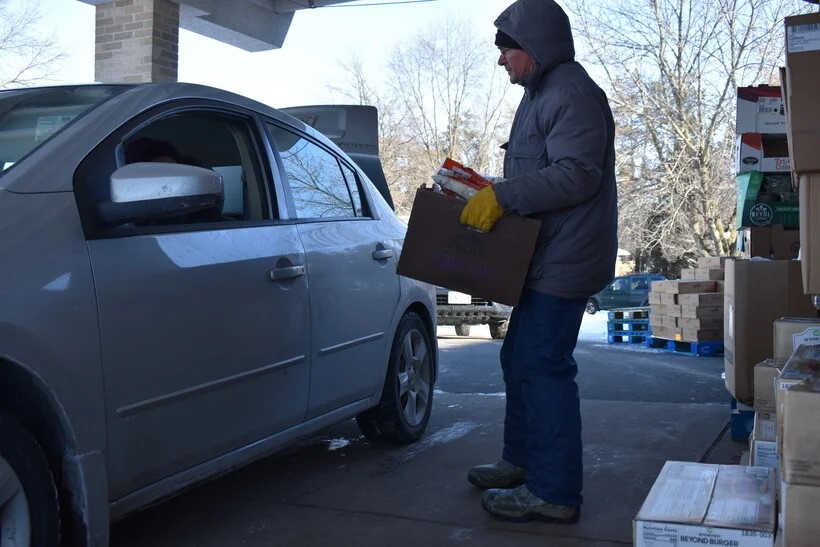State Poverty Below 2008 High, But Still Greater Than 20 Years Ago
New report finds falling manufacturing employment, union membership driving down wages.

Tim Kapfhamer of St. Bernard’s Catholic Church carries a box of food to the car of a social worker who will distribute it to rural families, February 2, 2023. Rob Mentzer/WPR
Poverty in Wisconsin has come down from highs registered following the 2008 recession but remains higher than it was two decades ago.
That’s according to a new report from the University of Wisconsin-Extension, which examined the state’s poverty rate over time compared to neighboring states.
Over the last 30 years, Wisconsin registered its lowest poverty rates between 1995 and 2003, the report said. During that period, the poverty rate hovered around 9 percent and stayed below that number from 1998 to 2003, falling to a low of 8.1 percent.
Steven Deller, the report’s author and an agricultural and applied economics professor at UW-Madison, said he attributes the state’s inability to return to the low poverty rates it saw in the late ’90s and early 2000s to a shift away from more highly-paid manufacturing jobs toward a more service-based economy, the state’s decline in unionization and a slow recovery from the Great Recession.
In March 2000, Wisconsin had 600,000 manufacturing jobs. By March of this year, that number had fallen by 19 percent to 485,500, according to data from the Federal Reserve. In 2000, 456,000 Wisconsinites were members of a labor union, but that number fell by nearly 60 percent to 187,000 last year, according to the U.S. Bureau of Labor Statistics.
“Because unionization has been declining, that’s putting downward pressure on wages,” Deller said. “We’re shifting away to more of a service based economy, (with jobs in) tourism, recreation, personal services, and those jobs tend not to pay quite as well.”
Deller said the late ’90s and early 2000s were “good economic times” in Wisconsin that saw income and job growth. Poverty started to gradually climb in 2004, before spiking after the 2008 recession, the report said. From 2010 to 2014, the poverty rate remained above 13 percent. Poverty rates didn’t return to pre-recession levels until 2019.
“We weren’t hit as hard by the great recession as a lot of other states, but it took us longer to come out of it,” Deller said.
He compared Wisconsin’s recovery to that of Minnesota, which consistently has lower levels of poverty than the Badger state.
Deller said the early 2010s, when poverty peaked in Wisconsin, was a time of “fiscal austerity” where the state government looked to cut spending and not raise taxes. During the same period, he said Minnesota raised taxes and spending temporarily to combat the effects of the 2008 recession.
In fact, Minnesota’s poverty rate decreased each year from 2011 to 2013, while Wisconsin’s continued to climb each year, according to the report.
“Minnesota recovered from the Great Recession much faster than Wisconsin did,” Deller said.
Poverty rates in Wisconsin continued on a downward trend from 2014 to 2020, bottoming out around about 10 percent, before creeping back up in 2021 to just under 11 percent, the report said.
“The COVID stimulus money helped drive the poverty rate down (in 2020),” Deller said. “Then when that stimulus money went away, but we still have lingering effects of COVID, the poverty rate jumps back up again.”

This graphic compares poverty rates between Wisconsin, Michigan, Illinois, Minnesota and Iowa. Wisconsin’s poverty rate most closely resembled Iowa’s but with lower valleys and higher peaks. The state consistently has a lower poverty rate than Illinois and Michigan, but higher than Minnesota. Photo Courtesy of the University of Wisconsin-Extension
When compared to its neighbors, Wisconsin’s poverty rate most closely resembled Iowa’s but with lower valleys and higher peaks, the report said. The state consistently has a lower poverty rate than Illinois and Michigan, but higher than Minnesota.
But poverty rates don’t necessarily paint the full picture of who’s struggling to make ends meet, said Charlene Mouille, president and CEO of United Way of Wisconsin.
The United Way describes those who earn more than the federal poverty level but not enough to afford necessities as being “Asset Limited, Income Constrained, Employed” — or ALICE. Total households below the ALICE Threshold include those individuals and households below the federal poverty level.
According to a 2023 report from United Way, about 34 percent of Wisconsin households were below the ALICE threshold in 2021, 22 percent of whom were above the poverty threshold. Mouille said ALICE takes into account the conservative estimates on the cost of necessities like housing, food, transportation, health care and childcare.
“People just feel like they’re not catching up,” Mouille said. “(The poverty rate is) a decent measure, but it’s not a measure that’s really reflective of people that are living with lower income and what the reality is.”
Deller said poverty rates are an indicator that often goes overlooked when talking about the economy. But he said it can be a helpful metric for economic development officials.
“We’ve got to stop thinking about jobs, jobs, jobs,” he said. “We can’t fill the positions that we have. Now, we need to start thinking about the quality of the jobs, and that’s when you start thinking about things like wages and benefits.”
Listen to the WPR report here
Wisconsin poverty has come down from highs of the 2008 recession, but still above early 2000s lows was originally published by Wisconsin Public Radio






















The UW “report” is just a short blog post?. It’s maybe 3 paragraphs long with a chart. Is there an actual report somewhere besides his website that contains data, methodology, and analysis?
He points out the 5 counties with the highest rate but provides no analysis of the economic factors within each of those specific counties.
Menominee tops the list, and the county is essentially their reservation. It’s hard to imagine that county has experienced a drop in a large manufacturing base, or decline in union jobs. Same for #3 #4 and #5 counties. Milw county (#2 on the list) is the only county of the top 5 that the explanation seems plausible.
Interesting comparison with our neighbors, wish there was an actual report.